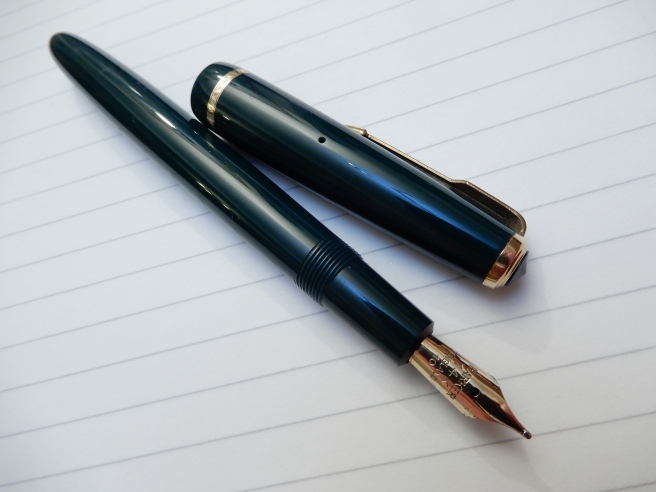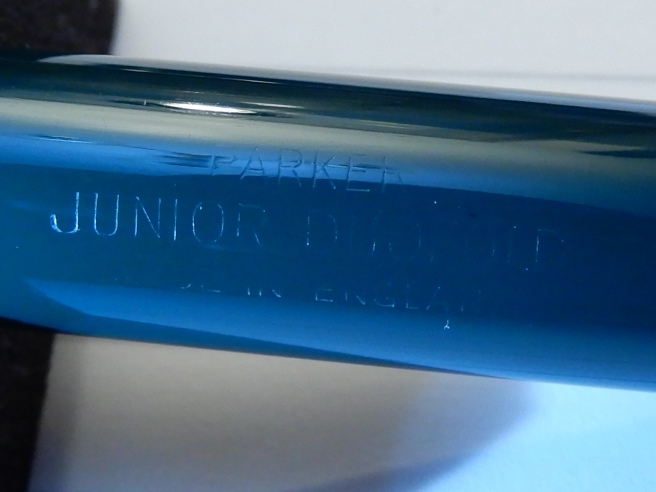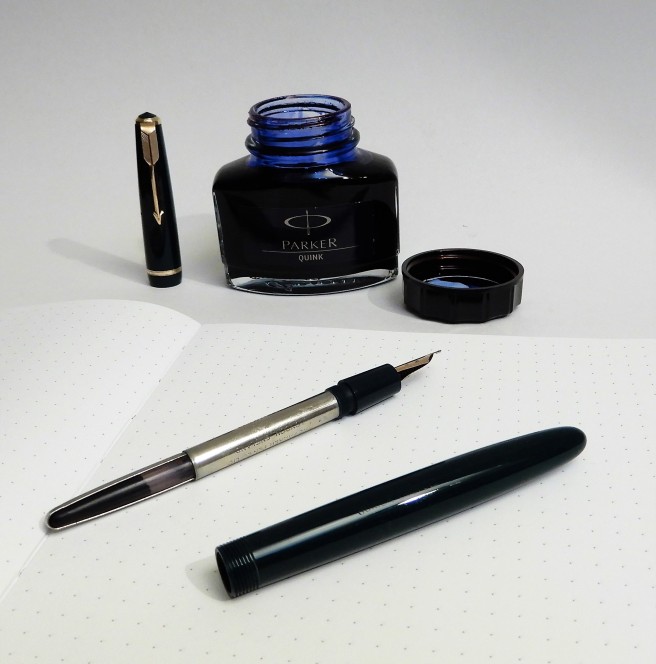One of my lucky finds at the recent Cambridge pen show was this lovely Parker Junior Duofold, in dark green with gold fittings.

The pen is lovely in its own right, but had a particular attraction for me, being a close match to the pen that my mother bought for me in 1970 on the occasion of going to a new school. Sadly and inevitably, I managed to lose it within a few weeks and for the next seven school years, used a succession of less valuable Parker fountain pens.
Description
The pen has a classic, timeless look, in British Racing Green resin (think of a 1920’s Bentley at Le Mans), with a 14k gold nib, which looks like a Broad but has no width description showing, and a simple, fixed aerometric type squeeze bar filler. It has a screw cap, a shortish gold coloured arrow clip and a single gold coloured cap band with some engraved pattern but no text. The cap has two small drilled air holes in the sides which I presume are to avoid air pressure building in the cap. It is not a particularly big pen, by today’s standards but forms a generous length when posted and is smooth, light and comfortable to hold. The nib reads “PARKER, 14K, ENGLAND, 10”.

The pen measures 135mm long capped, 120mm open, or 160mm posted. It weighs just 15.5g closed or posted. Uncapped it is 10.5g and the cap alone weighs 5.0g.
Buying a vintage fountain pen can be a bit daunting. At a pen show, tables filled with row upon row of vintage pens can seem rather overwhelming unless you are looking specifically for something. There is the worry (assuming that you are buying a pen to use) of whether the nib writes well, whether the filling mechanism is still working and (unless you have researched any given model before hand) whether the price is right.
Being at least slightly prepared, I had a magnifying glass with me and was able to have a look at the nib and the tipping material, which looked to be in great shape. I also looked at the barrel and there found the very faint imprint, barely visible to the naked eye, “PARKER, JUNIOR DUOFOLD, MADE IN ENGLAND”. That clinched it.

I have heard it said that the Parker aerometric sacs rarely have anything wrong with them. You can test them by removing the cap and barrel, putting the nib to your ear and giving the squeeze bar a press, to feel a small puff of air, assuming that it is not inked, of course.
At home, I flushed the pen in clean water a few times. I was pleased to see that the sac filled easily with a few presses.
The writing experience
I filled the pen with Parker Quink, Blue-black, a rather obvious choice, I know. The glass bottles with their chunky plastic caps and 57ml of inky goodness, seem not to have changed much (if at all) since I was a child, except that they are now sold in ugly blister packs instead of carboard boxes.

To my great pleasure and delight, this little pen wrote like a dream. It has a lot of what fountain pen enthusiasts crave, namely a buttery smooth nib, ideal ink flow, a little softness to the nib giving beautiful shading, comfortable handling, reliability and a bit of historical interest too.

A bit of Keats. Beautiful shading with Parker Quink Blue Black on Tomoe River paper. [should read “but still will keep”, not “with”, demonstrating that errors are only visible after publication].
In fact, looking across at my (ahem) 18 other currently inked pens, I could almost convince myself to put all the others away and just enjoy the Parker with its bottle of Quink. That is all I need, really.
I did not know very much about this range before buying one. Reading up afterwards on FPN, in a post by Malcy, I learned that Parker Duofolds of the 1950’s came in a range of models, with a corresponding number on the nib as follows:-
- Lady (4)
- Slimfold (5)
- Junior (10)
- Demi (15)
- Standard (25)
- Senior (35)
- Maxima (50)
Conclusion
Armed with this information I am interested now to handle some of the others in the range. It is nice to have something specific in mind to hunt for next time a pen show comes to town. Parker Duofold pens have been made for a long time and I feel that I have a lot more to learn.
Last Saturday I had another browse in the sumptuous fountain pen department at Selfridges in Oxford Street. (No, I managed to resist buying anything this time). I did linger in front of the current Parker Duofold, International, Big Red in a glass display case, but at £500.00 it is a lot of money. Happily, my vintage Junior Duofold cost me only £50.00 which seems a small price to pay for the pleasure it gives and for entry to the Duofold owners’ club.


I think you got a much better pen, at a fraction of the price, and with nice memories attached, too. Good work! 🙂
LikeLiked by 2 people
Thank you. I am enjoying this one a lot. Also, the sound of uncapping a bottle of Quink takes me straight back to the seventies. 😊
LikeLike
The best pens–like the best posts–come with interesting stories attached. I completely get why this would have an emotional value above and beyond dollars and cents. And that coloring is great, it reminds me of a TVR Chimaera a good friend of mine had back in the 1980s. Beautiful paint-job, but the best thing that could have happened to that car would have been to turn it into fountain pens 🙂
Great post. Great story, thank you!
LikeLiked by 1 person
Thank you. I wonder how many pens you could make from one TVR…😊
LikeLike
Ah, the Newhaven Duofold; in my opinion, one of the true greats. Built like tanks, indestructible filling system, lovely and often quirky/unique nibs. Some say they are boring. To me they epitomize what a pen should do; write well, for a very long time. I own a good half dozen or so, of different vintages, all standard size except for one Demi and a Senior with a cracked cap.
They are cheap as chips on eBay, due to there being so damn many of them still kicking: Slimfolds especially can be had for less than £20. They take a polish well, need a mere flush, and the nibs are firm enough to still be ready to write. Sorry for the long windedness, but I do love these pens. Glad to have you aboard, sir.
LikeLiked by 1 person
Thank you very much for this. I am now interested to compare some of the other vintage Duofold sizes and colours next time I visit a pen show.
LikeLiked by 1 person
First of all, you are very lucky since you have pen shows somewhat close to you. Here in Norway there does not exist such a thing! Not al all!!! :-).
I had once a Parker Duofold … and have it still. It looks beautifully with its Jade Green finish (it is called Jade Green), but unfortunately, the filling mechanism is destroyed. I did not touch it since years …
Thanks for the report of the pen show. It is very nice to read about these things …
LikeLiked by 1 person
Lovely pens…I found a couple of “Seniors” in my father’s belongings (one green, one black) and they are lovely to hold 142mm capped, big #35 nib). Had them professionally serviced – now as new – and love using them. Only issue is they’re inclined to be a bit “leaky” into the cap and onto the paper so a bit of a worry when taking out and enjoying … Pity.
LikeLike
These sound a great find and with a special sentimental value too. Given their age they can surely be forgiven for a little incontinence. Perhaps best used at home and stored upright in a pen cup.
LikeLike
Beautiful article, it is always a pleasure to read your writings.
I also have a Parker Duofold made in England, not Junior, but Senior; not blue but black.
It is beautiful: it looks like a new pen, never used.
Yet it has something strange, which I do not understand. The nib.
Is a 14k gold nib.Only one color tone.
There is a beautiful engraved arrow, the tip of which coincides with the tip of the nib.
The fletching of the arrow has 7 feathers.
Under the fletching, on three lines, these words are engraved:
14k
PARKER
VACUMATIC
REG.T.M.
I have never seen nibs of this type on Duofold 50s and 60s.
I’m wrong?
LikeLiked by 1 person
Thank you for your kind comments. From photographs I have seen of the Parker Duofold Senior, I would expect the nib to be a monotone gold with the size number 35. I have not seen one with an arrow tip and feathers design. Is your pen an aerometric filler or vacumatic? If it is the aerometric (squeeze bar) type then this is a clear hint that the nib was not originally intended for that pen.
LikeLike
Lovely story! I’ve also managed to pick up a junior at one of the antique shops in Angel, Islington, along with a vacuumatic, all together for £30. The senior still does its job (hooray!) but sadly the vaccumatic’s button fill system seems to be malfunctioning. Need to get that one fixed by a professional, such a beauty!
LikeLike
Lovely story! I’ve managed to pick up a junior alongside a vacuumatic on a recent wondering around at the antique shops in Angel, Islington. The 2 together was only £30 which was a bargain. The junior still works surprisingly well, but sadly, the vacuumatic’s button fill mechanism seems to be malfunctioning.
LikeLiked by 1 person
Thanks. That sounds a bargain. I hope that you can get the pen repaired. Good luck!
LikeLike